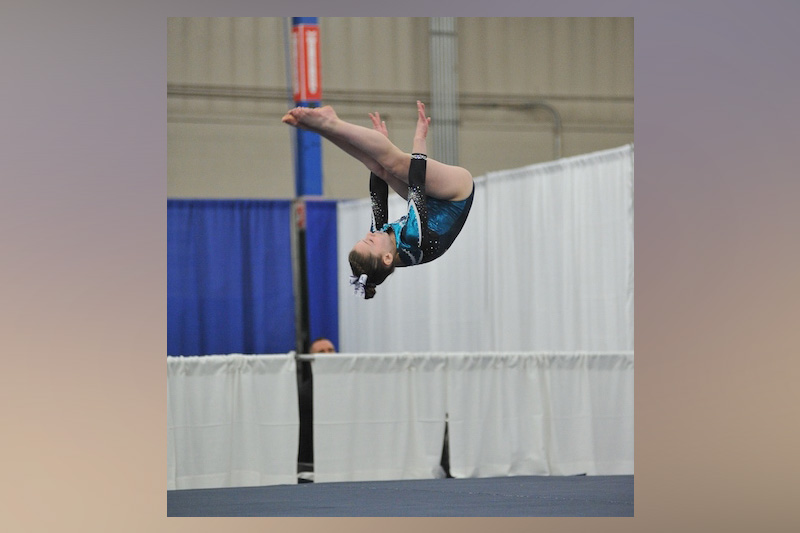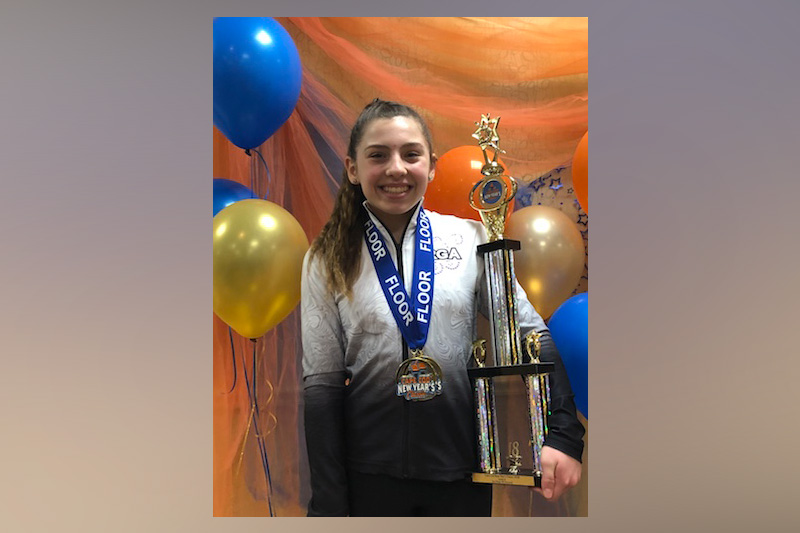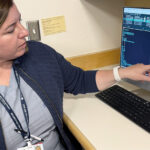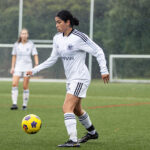A gymnast gets her spring back

In order to master the pirouette, Mikayla Comeiro drew on many of the strengths she’d developed as a competitive gymnast: hours of practice, determination and physical stamina. To perform a pirouette, the gymnast swings herself into a handstand on the uneven bars and walks her hands around in a circle, rotating her entire body while remaining upside down.
Mikayla worked on the skill last summer and executed the move at a competition in Virginia this past winter. “I love the feeling of success when you work really hard and do well at a competition,” she says. It was a satisfying comeback from the hip injury that forced Mikayla to take six months off from any sort of practice or competition last year.

Mikayla, who is now 13, first got involved in gymnastics at the age of 2, when she and her father attended parent-child classes together. “I just kept doing it and got really into it,” she explains. As Mikayla excelled, the sport became more demanding. During any given week, she and her teammates practice five days a week, for a total of 19 hours.
Ignoring her injury
When she first felt pain in her left hip, Mikayla waited for it to go away. Instead of getting better, however, the pain got worse. Eventually the pain grew so bad, she could barely walk. “It was hard to say something to my parents,” says Mikayla. “The pain had been going on for so long, I knew it was going to be something bad.” When she finally spoke up, her mother, Kim, brought her to see Dr. Lyle Micheli.
The Comeiro family knew Dr. Micheli well by then. Mikayla had been his patient in the Performing Artist Athletes Program for injuries to her foot, ankle, knee and back. “Gymnastics puts a lot of stress on the body,” says Kim, who knows from experience that injuries are a fact of life for competitive gymnasts. When neither physical therapy nor crutches relieved Mikayla’s hip pain, Dr. Micheli referred her to Dr. Sarah Jackson in the Sports Ultrasound Clinic.

A look inside the joint in motion
Sports ultrasound uses sound waves to create images of muscles, ligaments and joints as patients move them. This dynamic view enables clinicians to diagnose injuries with greater accuracy and begin appropriate treatment sooner.
In Mikayla’s case, the ultrasound revealed she had an avulsion fracture in her left hip. Avulsion fractures are particularly common in young athletes, who are prone to overuse injuries. Over time, rigorous training can cause a separation at the growth plate that lies between a large bone, such as the hip bone, and a small chunk of bone. Typically, the small chunk of bone grows into the larger bone as the child grows. But when an athlete puts continued stress on the area, the tendon pulls the growth plate and the small chunk of bone away from the larger bone.
Non-surgical hip repair
Dr. Jackson and her colleague Pierre d’Hemecourt determined that a platelet rich plasma (PRP) injection had a reasonable chance of healing Mikayla’s hip. PRP is a type of regenerative medicine, which repairs damaged tissues by triggering the body’s natural growth factors to help repair the damaged tissue. “She called us on a Sunday to give us their opinion,” says Kim. “That gave me a lot of confidence in her commitment.”
One problem remained, however. Despite an unusually high pain threshold, Mikayla does not like needles. “I was very nervous,” she admits. By then, however, she had been in pain and unable to practice for three months. Her teammates were learning new skills while she fell further and further behind. Her other treatment option would have been surgery, possibly with the use of screws, to repair her hip. She and her parents decided to give PRP injection a try.

On the day of the procedure, Dr. Jackson drew blood from Mikayla’s arm. Then, using a centrifuge, clinicians separated out the platelets so they could be injected into Mikayla’s injured hip. Using ultrasound technology, Dr. Jackson guided the needle directly into the damaged area. “She had to get the needle between two bones in an area that was very inflamed,” says Kim, who alternated between watching the screen and watching her daughter’s face. “It was clear Mikayla was uncomfortable.”
A long weekend
The whole family held its breath that weekend, waiting to see if Mikayla’s pain would go away. “The treatment was on Friday,” remembers Kim. “Saturday and Sunday were miserable.” Then, on Tuesday morning, something remarkable happened. “I asked Mikayla the same question I’d been asking her for several months, how’s your hip? For the first time, she told me she was not in pain.”
Recovering smarter, not harder
True to form, Mikayla wanted to return to the gym right away. Instead, she heeded Dr. Jackson’s advice and gave her hip time to heal. Six weeks later, in late July, she finally returned to practice. Even then, she had to avoid all jumping and other high-impact exercises for another month.

Looking back, Mikayla says she would go through the procedure again, even though she’s still no fan of needles. “My hip was in pain for 12 weeks and nothing else was working,” she says, adding, “The entire time, I was not able to do gymnastics.”
New skills, on and off the mat
Since her recovery, in addition to the pirouette, Mikayla has mastered the 1.5 punch. The move involves a round off, a jump, a front tuck and a one-and-a-half twist in midair. Then, the instant her feet touch the mat, she launches into another jump, flips and sticks her landing. “Adding the second jump wasn’t hard but it took me three months to learn the twist,” she says.
Kim is proud, relieved and interested in teaching her daughter the skill of self-knowledge. “Mikayla’s learning to listen to her body,” she says. “She knows, if there’s a problem, she needs to say something before it becomes severe.” She pauses, then adds, “It’s a work in progress.”
Learn more about the Performing Artist Athletes Program and the Sports Ultrasound Clinic.
Related Posts :
-

Ask a sports medicine specialist: Why are ACL tears so common among female athletes?
When an athlete is sprinting after an opponent who suddenly stops or changes direction, their anterior cruciate ligaments (ACLs) make ...
-

Forging a path back to school after orthopedic trauma
Orthopedic trauma can force children to miss school, sometimes for an extended period. But even when patients have regained enough ...
-

Jackie’s dreams of playing professional soccer back on track after ACL surgery
From her dorm in Newcastle, England, Jackie Zapata can hear fans roaring in the soccer stadium a few blocks away. ...
-

What orthopedic trauma surgeons wish more parents knew about lawnmower injuries
Summer is full of delights: lemonade, ice cream, and fresh-cut grass to name a few. Unfortunately, the warmer months can ...





